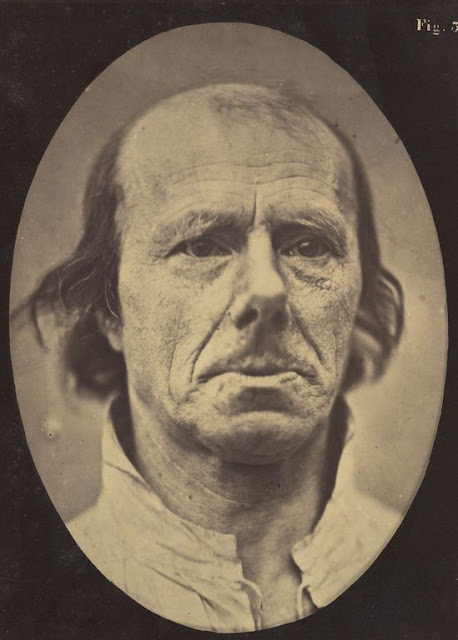Influenced by the fashionable beliefs of physiognomy of the 19th century, Guillaume-Benjamin-Amand Duchenne de Boulogne wanted to determine how the muscles in the human face produce facial expressions which he believed to be directly linked to the soul of man.
He is known, in particular, for the way he triggered muscular contractions with electrical probes, recording the resulting distorted and often grotesque expressions with the recently invented camera. He published his findings in 1862, together with extraordinary photographs of the induced expressions, in the book Mecanisme de la physionomie Humaine (The Mechanism of Human Facial Expression, also known as The Mechanism of Human Physiognomy).
Duchenne believed that the human face was a kind of map, the features of which could be codified into universal taxonomies of mental states; he was convinced that the expressions of the human face were a gateway to the soul of man.
Unlike Lavater and other physiognomists of the era, Duchenne was skeptical of the face's ability to express moral character; rather he was convinced that it was through a reading of the expressions alone (known as pathognomy) which could reveal an "accurate rendering of the soul's emotions". He believed that he could observe and capture an "idealized naturalism" in a similar (and even improved) way to that observed in Greek art. It is these notions that he sought conclusively and scientifically to chart by his experiments and photography and it led to the publishing of The Mechanism of Human Physiognomy in 1862, now generally rendered as The Mechanism of Human Facial Expression.
(via Mashable/Retronaut)
He is known, in particular, for the way he triggered muscular contractions with electrical probes, recording the resulting distorted and often grotesque expressions with the recently invented camera. He published his findings in 1862, together with extraordinary photographs of the induced expressions, in the book Mecanisme de la physionomie Humaine (The Mechanism of Human Facial Expression, also known as The Mechanism of Human Physiognomy).
Duchenne believed that the human face was a kind of map, the features of which could be codified into universal taxonomies of mental states; he was convinced that the expressions of the human face were a gateway to the soul of man.
Unlike Lavater and other physiognomists of the era, Duchenne was skeptical of the face's ability to express moral character; rather he was convinced that it was through a reading of the expressions alone (known as pathognomy) which could reveal an "accurate rendering of the soul's emotions". He believed that he could observe and capture an "idealized naturalism" in a similar (and even improved) way to that observed in Greek art. It is these notions that he sought conclusively and scientifically to chart by his experiments and photography and it led to the publishing of The Mechanism of Human Physiognomy in 1862, now generally rendered as The Mechanism of Human Facial Expression.
 |
| "The face of an old man... photographed in repose." |
 |
| "The grimace produced is similar to a tic of the face." |
 |
| "A study of m. frontalis in maximum contraction." |
 |
| "Showing the expressive lines of m. frontalis in a young girl." |
 |
| "A study of the contraction of and the expression produced by the superior part of m. orbicularis oculi" |
 |
| "Expression of severity." |
 |
| "On the right, electrization of m. procerus: severity, aggression. On the left: attention." |
 |
| "Aggression, wickedness." |
 |
| "Suffering." |
 |
| "Profound suffering, with resignation." |
 |
| "Extreme pain to the point of exhaustion, the head of Christ and memory of love or ecstatic gaze." |
 |
| "Expression of painful attention and attentive gaze." |
 |
| "Expression proportionally more pained." |
 |
| "Grimace." |
 |
| "Scornful laughter and scornful disgust." |
 |
| "The attention attracted by an object that provokes lascivious ideas and desires." |
 |
| "Pain and despair." |
 |
| "A suggestion of this same weeping." |
 |
| "Mild weeping, pity and feeble false laughter." |
 |
| "Voluntary retraction of the lower lip." |
 |
| "Whimpering and false laughter." |
 |
| "Voluntary lowering of the lower jaw." |
 |
| "Surprise." |
 |
| "Astonishment, stupefaction, amazement." |
 |
| "Terror, semiprofile." |
 |
| "Expression of terror." |
 |
| "Scene of coquetry." |
 |
| "Lady Macbeth, strong expression of cruelty." |
 |
| “This expression must be that of the damned.” |
 |
| "Painful weeping and forward looking." |
 |
| "Nun saying her prayers." |
 |
| "Lady Macbeth, moderate expression of cruelty." |
 |
| "Lady Macbeth, ferocious cruelty." |
 |
| "Terror." |
 |
| "Faradisation of the frontal muscle." |
(via Mashable/Retronaut)

.jpg)





